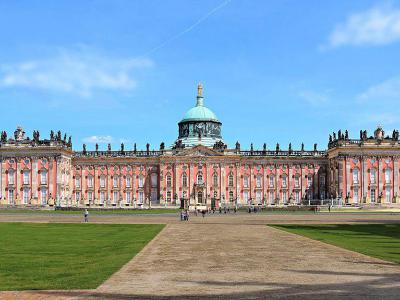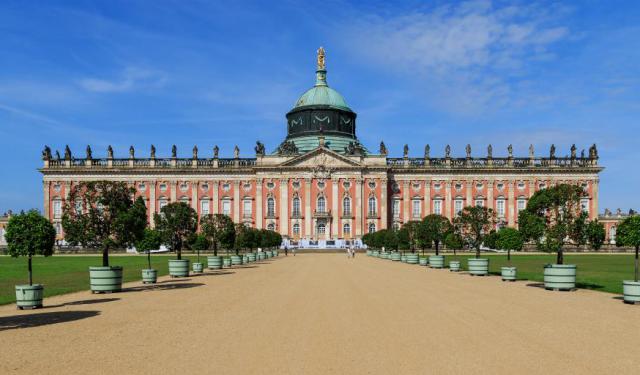New Palace, Potsdam (must see)
The New Palace is a palace in Sanssouci Park. It was built at the behest of Frederick the Great in order to celebrate Prussia at the end of the Seven Year's War.
Construction on the New Palace began in 1763 and was completed in 1769. It was designed by architects Johan Gottfried Buring, Heinrich Ludwig Manger and Carl von Gontard in the Baroque and Rococo architectural styles. Frederick the Great insisted that the palace be overly adorned with marble, stone and gilt to show the wealth and success of Prussia.
Built with more than 200 rooms, the New Palace was not used as a primary residence but as a place to meet dignitaries and other royals. Frederick the Great kept a suite at the New Palace for his occasional stays. The suite includes two antechambers, a study, a dining salon, a concert room and a bedroom.
As a lover of art, Frederick the Great insisted the New Palace be decorated with fine pieces from well-known artists of the time. The palace had over 400 sandstone statues by sculptors such as Johann Peter Benckert, Johann Matthias Gottlieb Heymuller and brother Johann David and Johann Lorenz Rants.
The New Palace underwent a series of changes over the years. For instance, in the early 19th century, Frederick III had a moat dug around the palace. At the turn of the century, Wilhelm II had steam heating and electric chandeliers installed. After the November Revolution, the New Palace became a museum.
Little damage was done to the New Palace during World War II. However, the Soviet Army looted the palace and removed much of the art and furnishings. For more than two decades, those items were lost. In the 1970s, most of the furnishings were discovered still in packing crates and in excellent condition. They were returned to the palace, which has allowed it to retain the appearance it did prior to the war.
The New Palace was designated as a UNESCO World Heritage Site in 1990.
Construction on the New Palace began in 1763 and was completed in 1769. It was designed by architects Johan Gottfried Buring, Heinrich Ludwig Manger and Carl von Gontard in the Baroque and Rococo architectural styles. Frederick the Great insisted that the palace be overly adorned with marble, stone and gilt to show the wealth and success of Prussia.
Built with more than 200 rooms, the New Palace was not used as a primary residence but as a place to meet dignitaries and other royals. Frederick the Great kept a suite at the New Palace for his occasional stays. The suite includes two antechambers, a study, a dining salon, a concert room and a bedroom.
As a lover of art, Frederick the Great insisted the New Palace be decorated with fine pieces from well-known artists of the time. The palace had over 400 sandstone statues by sculptors such as Johann Peter Benckert, Johann Matthias Gottlieb Heymuller and brother Johann David and Johann Lorenz Rants.
The New Palace underwent a series of changes over the years. For instance, in the early 19th century, Frederick III had a moat dug around the palace. At the turn of the century, Wilhelm II had steam heating and electric chandeliers installed. After the November Revolution, the New Palace became a museum.
Little damage was done to the New Palace during World War II. However, the Soviet Army looted the palace and removed much of the art and furnishings. For more than two decades, those items were lost. In the 1970s, most of the furnishings were discovered still in packing crates and in excellent condition. They were returned to the palace, which has allowed it to retain the appearance it did prior to the war.
The New Palace was designated as a UNESCO World Heritage Site in 1990.
Want to visit this sight? Check out these Self-Guided Walking Tours in Potsdam. Alternatively, you can download the mobile app "GPSmyCity: Walks in 1K+ Cities" from Apple App Store or Google Play Store. The app turns your mobile device to a personal tour guide and it works offline, so no data plan is needed when traveling abroad.
New Palace on Map
Sight Name: New Palace
Sight Location: Potsdam, Germany (See walking tours in Potsdam)
Sight Type: Attraction/Landmark
Guide(s) Containing This Sight:
Sight Location: Potsdam, Germany (See walking tours in Potsdam)
Sight Type: Attraction/Landmark
Guide(s) Containing This Sight:
Walking Tours in Potsdam, Germany
Create Your Own Walk in Potsdam
Creating your own self-guided walk in Potsdam is easy and fun. Choose the city attractions that you want to see and a walk route map will be created just for you. You can even set your hotel as the start point of the walk.
Sanssouci Park Walking Tour
Sanssouci Park is a unique Potsdam landmark that occupies 290 hectares in the heart of the city. The Park is named after the Sanssouci Palace that it surrounds, which in turn takes its name from the French phrase "sans souci", which means carefree, and implies that the palace was designated as a place of fun, rather than a seat of power.
Indeed, the Sanssouci Palace was built in 1747... view more
Tour Duration: 2 Hour(s)
Travel Distance: 3.9 Km or 2.4 Miles
Indeed, the Sanssouci Palace was built in 1747... view more
Tour Duration: 2 Hour(s)
Travel Distance: 3.9 Km or 2.4 Miles
Neuer Garten Walking Tour
Laid out at the behest of Friedrich William II in 1787, Potsdam's Neuer Garten (New Garden) was indeed "new" compared to the already in place Sanssouci Park.
Between 1816 and 1828, the area was modified further as an English-style, open landscape garden, with an aim to reproduce nature – trees and plants were left to grow naturally, unshaped and untrimmed. Rural life was also... view more
Tour Duration: 2 Hour(s)
Travel Distance: 2.8 Km or 1.7 Miles
Between 1816 and 1828, the area was modified further as an English-style, open landscape garden, with an aim to reproduce nature – trees and plants were left to grow naturally, unshaped and untrimmed. Rural life was also... view more
Tour Duration: 2 Hour(s)
Travel Distance: 2.8 Km or 1.7 Miles
Potsdam Introduction Walking Tour
Potsdam was likely founded during the seventh century by the Hevelli tribe. The town was mentioned by the name of Poztupimi in a document from Emperor Otto III. The name likely came from an old Western Slavonic term roughly meaning "beneath the oaks."
By the early 1300s, a small town had formed with a town charter. By 1573 the town had around 2,000 people living there. Potsdam rose to... view more
Tour Duration: 2 Hour(s)
Travel Distance: 3.8 Km or 2.4 Miles
By the early 1300s, a small town had formed with a town charter. By 1573 the town had around 2,000 people living there. Potsdam rose to... view more
Tour Duration: 2 Hour(s)
Travel Distance: 3.8 Km or 2.4 Miles






